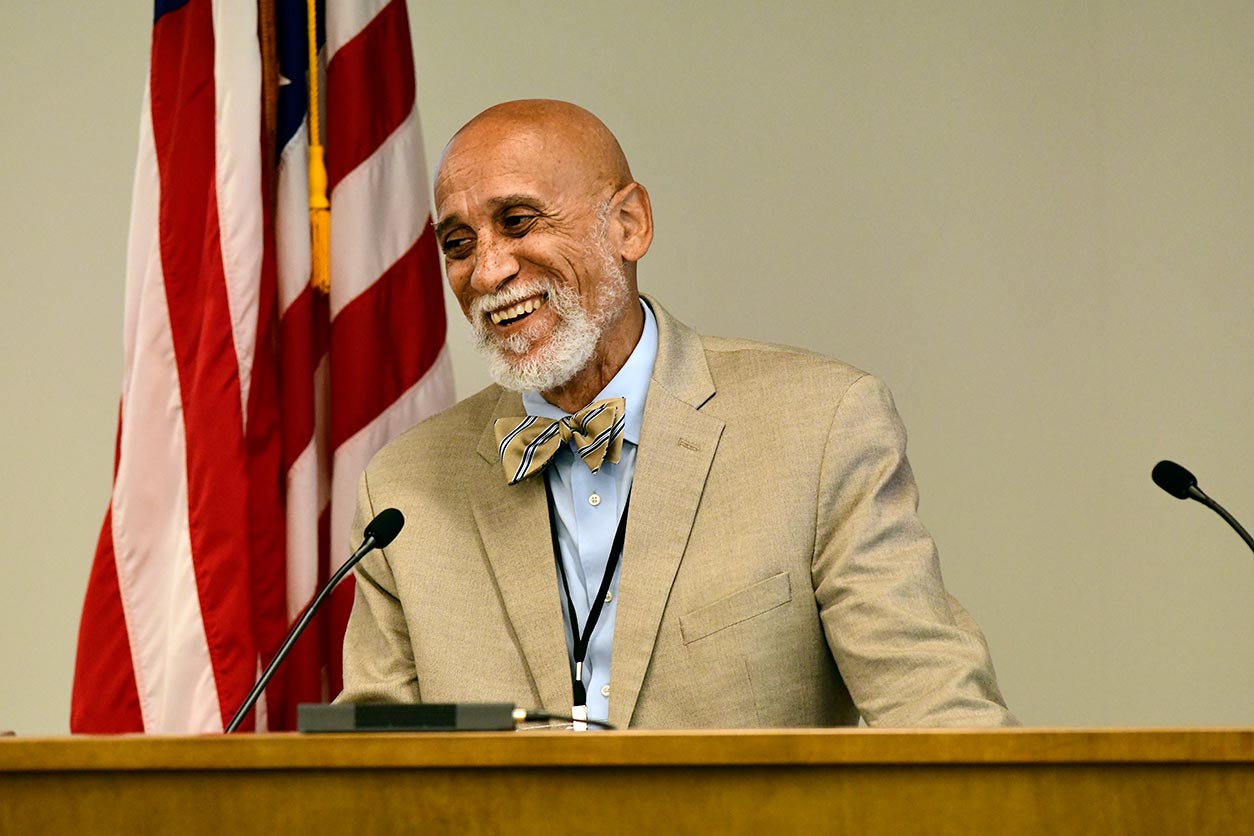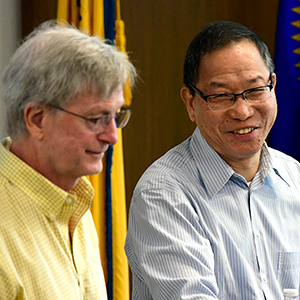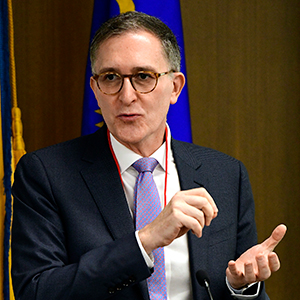NIEHS initiatives to advance the study of DNA and RNA modifications linked to environmental insults headlined the recent National Advisory Environmental Health Sciences Council meeting. NIEHS Director Rick Woychik, Ph.D., together with institute leaders, scientists, and grant recipients, reported the latest research updates to the advisory board Feb. 12-13.
They shared progress to guide the scientific community’s study of the exposome, develop a new model for environmental justice, and onboard new leaders — including a National Institutes of Health (NIH) Director and Division of Translational Toxicology Scientific Director.
The Council is a Congressionally mandated body that meets three times a year to advise Woychik on the direction of research, training, and career development supported by NIEHS. The Council also provides secondary review of research grant applications.

Environment changes DNA, RNA
NIEHS Program Director Fred Tyson, Ph.D., organized a mini-symposium highlighting the work of researchers who are exploring the environment’s impacts on epigenetic changes to DNA (epigenomics) and RNA (epitranscriptomics). NIEHS has actively supported research at the intersection of the environment and the epigenome for almost three decades.
“Recognizing the potential impact of environmental toxicants on RNA modifications and how this may be mechanistically associated with a number of health outcomes, NIEHS embarked on developing a portfolio in 2017 that would integrate exposures with epitranscriptomics research,” Tyson explained.
Today, seven years later, NIEHS is supporting more than 35 active grants that address exposures and epitranscriptomics.

The following NIH-supported scientists presented their exciting research during the Council meeting.
- Yingsheng Wang, Ph.D., shared his use of multi-omics approaches to examine the role of CAG repeat RNA in neurodegenerative diseases, including Huntington disease and diseases marked by accumulations in the protein TDP-43. Using various lab models, including cell, worm, fly, and mouse models, Wang and his University of California, Riverside team demonstrated the longer the repeat, the more enzyme activity, leading to cellular disruptions.
- Yvonne Fondufe-Mittendorf, Ph.D., of the Van Andel Institute, discussed her team’s efforts and models to understand how arsenic causes cancer. Fondufe-Mittendorf showed that arsenic directly alters chromatin primary and tertiary (3D) structures, which are a mixture of DNA and proteins, leading to altered gene expression patterns that promote oncogenesis. Arsenic also increases the expression of a circular RNA that perturbs higher-order chromatin structure, which likewise drives cancer.
- Justin Colacino, Ph.D., a former ONES awardee of the University of Michigan, described his use of single cell methods. The goal: digging into the spatial distribution of markers at the tissue level to investigate environmental exposure disparities and cellular plasticity, or a cell’s shifting identity from a luminal cell to a basal cell.
- Victor Corces, Ph.D., of Emory University, discussed how environmental effects can lead to an inherited epigenetic defect that is passed from generation to generation. He shared research showing changes in the epigenome can be inherited across generations. He found bisphenol A (BPA) caused transcriptional changes that resulted in inheritance of BPA-induced obesity across generations of mice.
- Tom Begley, Ph.D., of the RNA Institute and a 2006 ONES grantee, explained how transfer RNA (tRNA) is regulated by stress and environmental exposures. He shared evidence showing the epitranscriptome is reprogrammed in mice in response to environmental tobacco smoke. “Connecting the exposome to the epigenome and using that as a filter to get to the epitranscriptome is where we need to go,” he said.
- “Differential RNA modifications that correlate with disease can dramatically change with a single amino acid mutation,” said Yunsun Nam, Ph.D., a biochemist and structural biologist at the University of Texas Southwestern Medical Center. Nam discussed her efforts to understand what is happening structurally at the atomic level. She aims to provide new insights into how the RNA and protein machinery work together in the hopes of uncovering signaling pathways that can be regulated or fixed.
- Ting Wang, Ph.D., a genome scientist at Washington University in St. Louis, explained that the environment affects the genome and epigenome, and cancer evolves from genetic and epigenetic causes. He shared that transposable elements can become demethylated — an epigenetic change — which can lead to highly expressed oncogenes even in the absence of a genetic mutation. “Epigenetics is reversible, the epigenome is targetable, so this presents an opportunity for us to trick cancer cells to produce new antigens and target transposable elements for cancer therapy,” Wang said.

Director’s report to Council
Dr. Woychik briefed Council members on the biggest news since they met last September: Monica Bertagnolli, M.D., was confirmed as the NIH new director.
According to Woychik, Bertagnolli’s vision centers on involving and reaching all communities with the knowledge and discoveries generated in NIH labs and clinics, so that all people are living long and healthy lives. She also seeks to bolster collaboration across the 27 institutes and centers, harness the power of artificial intelligence and machine learning to advance research, and improve the public’s confidence in science.
“In my conversations with her, it’s clear that she is excited about learning more about how to integrate a greater awareness of the role of the environment and the exposome into the fabric of the efforts across the NIH to study the etiology of disease,” Woychik said.
Woychik also shared updates about emerging scientific priority areas, including the exposome (see sidebar), a new climate change and health intramural virtual research center, and environmental justice.
Of note, following up on the “all of government” community forum last November in Burlington, North Carolina coordinated by Sharon Beard, Liam O’Fallon, Darlene Dixon, and Joan Packenham, Woychik announced that the U.S. Army Environmental Command will begin excavating as much as 300 tons of contaminated soil at the Western Electric Tarheel Army Missile Plant. This was the first time in decades that progress was made to work with the environmental justice community to get the site cleaned up.

“We would like to take this model of NIEHS serving as a convener and coordinator and bring it to other environmental justice communities across the United States,” Woychik said.
(Caroline Stetler is Editor-in-Chief of the Environmental Factor, produced monthly by the NIEHS Office of Communications and Public Liaison.)









